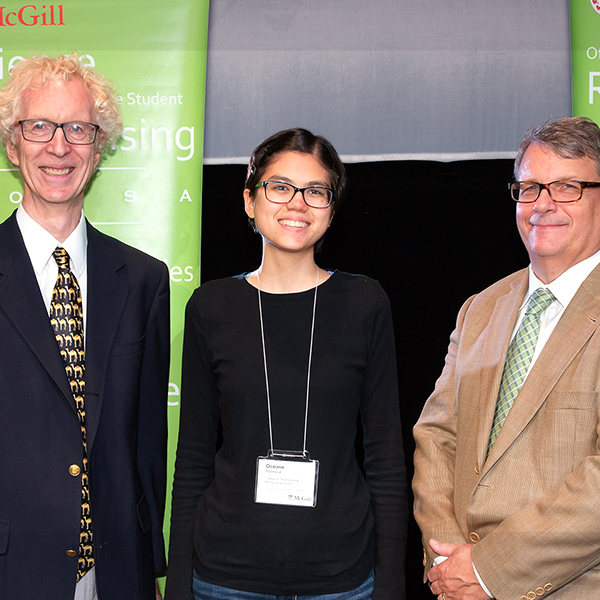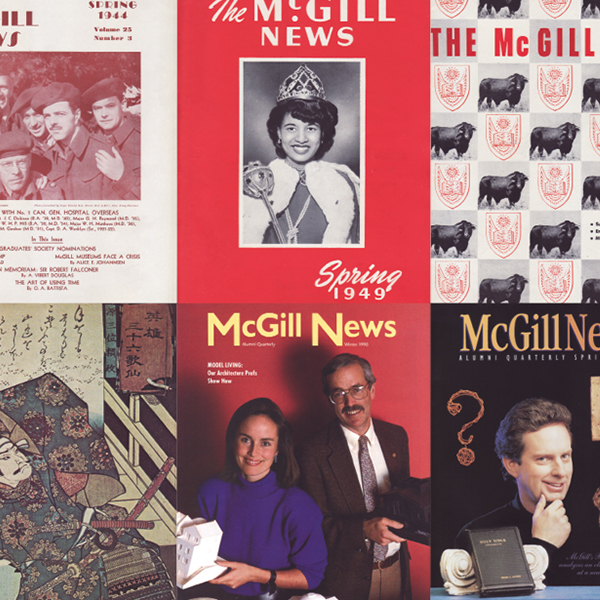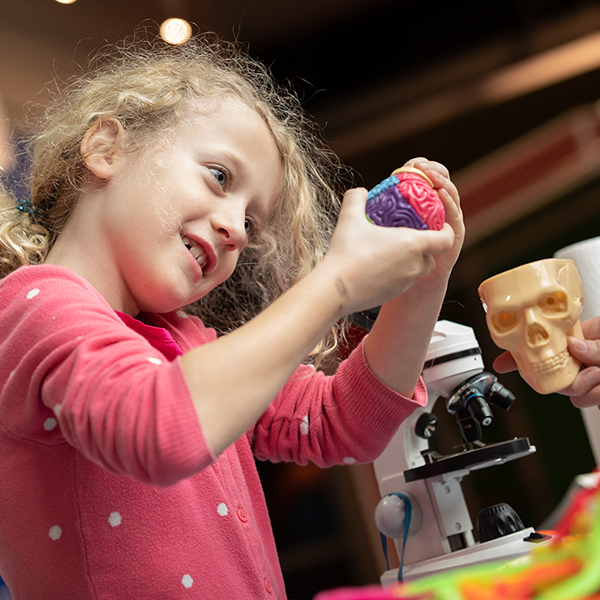Ducks – rubber ducks, Donald Duck, ducks of all sorts – crowd the bookshelves of Joe Schwarcz’s office. “The ducks are here to remind me that we’re always surrounded by quacks, and we need to battle them,” says Schwarcz, BSc’69, PhD’74, the director of McGill’s Office for Science and Society (OSS).
This spring, Schwarcz and his OSS team are celebrating 25 years of battling pseudoscience quackers and “separating sense from nonsense” – as the tagline on the OSS website states.
The OSS, born in 1999 as the Office for Chemistry and Society (OCS) before changing its name and embracing all science a few years later, first consisted of three collaborators: Schwarcz, David Harpp and Ariel Fenster, PhD’73. The trio began working together in 1980 when they created an exhibition about chemistry that attracted tens of thousands to Montreal’s Expo ’67 site.
The team gave frequent public lectures and created popular courses designed to both inform and entertain, including still-running online courses at McGill such as The Chemistry of Drugs and The Chemistry of Food (the latter of which recently boasted an enrollment of over 2,000 students). In 2014, the OSS launched Food for Thought, a MOOC (massive open online course) based on The Chemistry of Food, which has now been taken by upwards of 70,000 students.
The team has also grown. Emily Shore, BA’07, DipPRMgmt’12, joined the OSS in 2010 as its public affairs and communications coordinator – “She basically runs everything!” says Schwarcz – and the office is now home to a stable of science communicators and a changing cast of student interns.
While Fenster has retired, Harpp, holder of the Tomlinson Chair in Science Education, continues to serve as a consultant, as does Lorne Trottier, BEng’70, MEng’73, DSc’06, whose gifts to the University have played a key role in supporting the OSS. The OSS-hosted Trottier Public Science Symposium, an annual public event, regularly brings leading scientists, policy experts, prominent journalists, and others to McGill, where they tackle topics ranging from the possibility of extra-terrestrial life to the role of science in the world of sport.
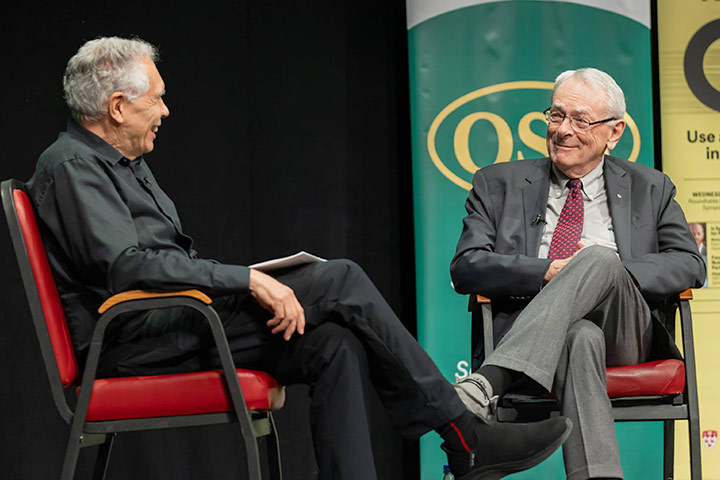
A quarter-century of growth has seen the OSS find new ways to fight pseudoscience and demystify the workings of evidence-based science.
“Twenty-five years ago, the internet was still in a fledgling state,” says Schwarcz. “Now, we’re using it to its full capacity, so we have certainly increased our reach.” Schwarcz’s popular radio show The Dr. Joe Show, which has run for an astonishing 43 years and was an established asset in the early days of the OSS, is now also available as a podcast.
The OSS’s weekly newsletter boasts 35,000 subscribers, supplemented by Instagram and Facebook posts as well as Schwarcz’s “The Real Chemistry” weekly columns in the Montreal Gazette, which are accompanied by videos also posted on the OSS site and its YouTube channel.
Other OSS members also enjoy prominent media profiles: science communicator Jonathan Jarry, BSc’03, who replaced the retired Fenster in 2017, appears in weekly segments on CTV Montreal and co-hosts The Body of Evidence podcast with OSS associate Christopher Labos, MDCM’06, MSc’14, a cardiologist who also writes a regular Gazette column focusing on health and medicine. All combined, the OSS’s trademark mix of science with a dose of playful whimsy reaches over 100,000 people weekly.
“COVID opened the door to a tsunami of misinformation, about everything. Once all the nonsense about vaccines began spreading, those tentacles got into many other areas, too.”
Joe Schwarcz, director of McGill’s Office for Science and Society
But even with those numbers, the office faces a daunting task. “COVID opened the door to a tsunami of misinformation, about everything,” says Schwarcz. “Once all the nonsense about vaccines began spreading, those tentacles got into many other areas, too. So, there’s a huge selection of battles to pick with so much quackery out there.”
Schwarcz generally keeps his articles and videos topical. He is never at a loss for subjects to address. “Every morning, I turn on my computer to find a dozen things to deal with.”
Recent OSS stories include an exploration of the growth of “eminence-based” (as opposed to evidence-based) medicine, where famous individuals with or without a science background endorse particular therapies; an analysis of the MOSH protein bar’s dubious claims about helping to “delay” Alzheimer’s, and investigations of the (false) theories that coffee stunts growth and that playing Mozart to infants can transform them into little geniuses.
Many scientific myths have their roots in media distortions of studies or in studies that were poorly carried out and could not be replicated (replication being fundamental to scientific verification). And people can become very attached to these misbeliefs.
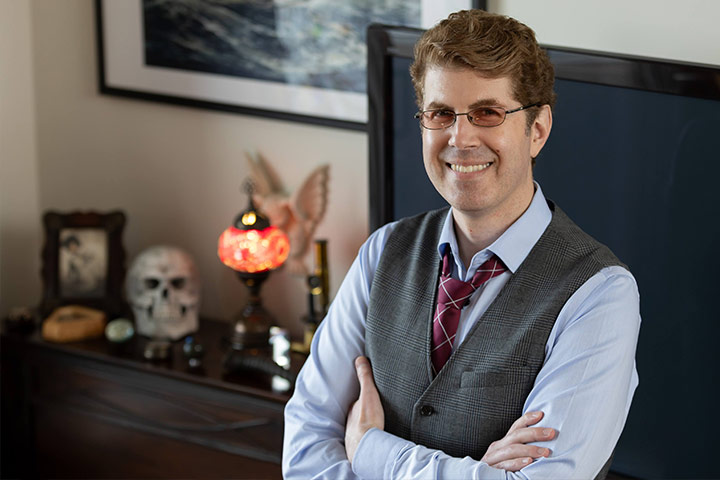
Says Jarry, “A lot of pseudoscience has roots in conspiracy theories, so our feedback runs the entire gamut. While many people write us glowing emails, we also get those who push back, usually referring to very poorly done research to argue why their particular belief is true. And some send long, conspiracy-mongering articles, sometimes with accusations of [us] being in the pocket of Bill Gates or the World Health Organization or the pharmaceutical industry.”
Sometimes the OSS receives corporate pushback as well, should an article happen to criticize a product (as they often do!). The OSS recently fought off threats of legal action over an article written years earlier by Ada McVean, BSc’19, MSc’22, a regular contributor who began working with the OSS while she was still a student at McGill.
“Joe fought them tooth and nail,” she says of the incident. “He went through every single claim, providing the scientific proof. He’s really good at defending us.”
McVean’s trajectory illustrates another goal of the OSS. “We want to educate students who can become good science communicators, because if you teach one student to be a good communicator, then that spreads the message,” says Schwarcz.
McVean joined as an undergraduate intern in May 2016; by 2019 she was a fully-fledged team member, and today she is based in London writing for the Royal Society of Chemistry while continuing to contribute to the OSS and writing a column for the New York-based The Skeptical Inquirer.
“I can’t underplay the role of the OSS in my career and my life,” she stresses. She credits Schwarcz with being a strong mentor. “Joe gives us freedom to pick our own topics and wander down whatever rabbit hole we find interesting,” she says. “I once pitched an article called “Can women ejaculate?” Joe straight up said ‘No, absolutely not’ [to the idea], but I wrote and submitted it anyway.”
Impressed with McVean’s analysis – which considered medical history, scientific and cultural sexism, and the latest research – Schwarcz decided to publish the piece.
“It’s important that we can push for articles that interest us because that makes for better, more engaging content,” says McVean.
And clear, engaging explorations of science and quackery means the OSS can reach its most important readers: the bewildered.
“People who are on the fence are my target audience,” says Jarry. “There’s so much information out there that it gets confusing for the average person. ‘Is this good for me? Is this bad?’ They just don’t know what to think. And when you can write an article that takes them through what is true about a claim and what isn’t, and how we know, you clarify things for them. And that can be very rewarding.”
“People will follow proper science if we clearly explain how we know what we know, and why they should believe us,” says Schwarcz. “And a lot of that means explaining how science works.”
And so the OSS continues to explain science and combat pseudoscientific folly, fakery and fraud. And while Schwarcz may have a flock of ducks – the legions of quacks! – at his back, he isn’t outnumbered. Flanking Schwarcz on his desk are bobble-heads of Isaac Newton as well as James Watson and Francis Crick of DNA fame, and figurines of renowned scientists Marie Curie, Louis Pasteur, Nikola Tesla, and Alfred Nobel.
Like the ducks, they are symbolic – they represent science in its best form: precisely what the OSS strives to share with the public in its mission of separating sense from nonsense.
